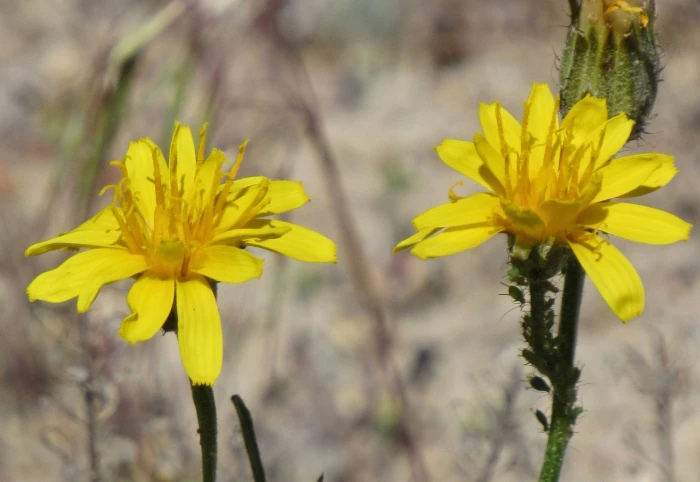Modoc Hawksbeard
(Crepis modocensis)
Modoc Hawksbeard (Crepis modocensis)
/
/

© Wendy McCrady
CC BY 4.0
Image By:
© Wendy McCrady
Recorded By:
Copyright:
CC BY 4.0
Copyright Notice:
Photo by: © Wendy McCrady | License Type: CC BY 4.0 | License URL: http://creativecommons.org/licenses/by/4.0/ | Uploader: wendybirds | Publisher: iNaturalist |
























Estimated Native Range
Climate Requirements
| • Precipitation | 7" - 55" |
| • High Temp. | 67°F - 95°F |
| • Low Temp. | -6°F - 31°F |
Summary
Crepis modocensis, commonly known as Modoc hawksbeard, is a perennial herb native to various habitats in western North America. It is typically found in open areas such as meadows, grasslands, and sagebrush steppes, often on rocky or well-drained soils. This species grows erect, reaching up to 18 inches tall, and is characterized by its woolly and sometimes bristly basal leaves. The inflorescence consists of 1 to 10 flower heads, each about 2 inches in diameter, with bright yellow ray florets that bloom in late spring to early summer. The flowers are quite showy and attract a variety of pollinators. The fruit is a black achene topped with a tufty white pappus, aiding in wind dispersal.
Modoc hawksbeard is valued for its bright yellow flowers and can be used in wildflower gardens, native plant landscapes, and restoration projects. It is relatively low-maintenance, requiring minimal water once established and thriving in poor, rocky soils with good drainage. It prefers full sun to partial shade. While generally not prone to serious diseases or pests, it can be susceptible to root rot in poorly drained soils. Gardeners should be aware that it may hybridize with Crepis atribarba, resulting in Crepis barbigera.CC BY-SA 4.0
Modoc hawksbeard is valued for its bright yellow flowers and can be used in wildflower gardens, native plant landscapes, and restoration projects. It is relatively low-maintenance, requiring minimal water once established and thriving in poor, rocky soils with good drainage. It prefers full sun to partial shade. While generally not prone to serious diseases or pests, it can be susceptible to root rot in poorly drained soils. Gardeners should be aware that it may hybridize with Crepis atribarba, resulting in Crepis barbigera.CC BY-SA 4.0
Plant Description
- Plant Type:
- Height: 1-2 feet
- Width: 0.5-1 feet
- Growth Rate: Moderate
- Flower Color: Yellow
- Flowering Season: Spring, Summer
- Leaf Retention: Deciduous
Growth Requirements
- Sun: Full Sun, Part Shade
- Water: Low
- Drainage: Fast, Medium, Slow
Common Uses
Bee Garden, Bird Garden, Butterfly Garden, Low Maintenance
Natural Habitat
Native to meadows, grasslands, and sagebrush steppes in western North America
Other Names
Common Names: Modoc Hawksbeard , Modoc Crepis , Siskiyou Hawk’s-Beard , Common Hawksbeard
Scientific Names: Crepis modocensis , Crepis modocensis var. modocensis
GBIF Accepted Name: Crepis modocensis